
Kid Icarus is a platform video game developed and published by Nintendo for the Family Computer Disk System in Japan and the Nintendo Entertainment System in Europe and North America. It was released in Japan in December 1986, in Europe in February 1987, and in North America in July.
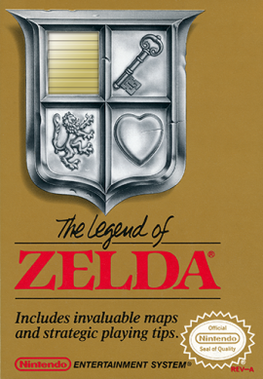
The Legend of Zelda, originally released in Japan as The Hyrule Fantasy: Zelda no Densetsu, is an action-adventure game developed and published by Nintendo. The first game of The Legend of Zelda series, it is set in the fantasy land of Hyrule and centers on an elf-like boy named Link, who aims to collect the eight fragments of the Triforce of Wisdom in order to rescue Princess Zelda from Ganon. The player controls Link from a top-down perspective and navigates throughout the overworld and dungeons, collecting weapons, defeating enemies and uncovering secrets along the way.

R.O.B. is a toy robot accessory for the Nintendo Entertainment System (NES). It was launched in July 1985 as the Family Computer Robot in Japan, and October 1985 as R.O.B. in North America. Its short lifespan yielded only two games in the Robot Series: Gyromite and Stack-Up.

Excitebike is a motocross racing video game developed and published by Nintendo. In Japan, it was released for the Famicom in 1984 and then ported to arcades as VS. Excitebike for the Nintendo VS. System later that year. In North America, it was initially released for arcades in 1985 and then as a launch game for the Nintendo Entertainment System later that year, becoming one of the best-selling games on the console. It is the first game in the Excite series.
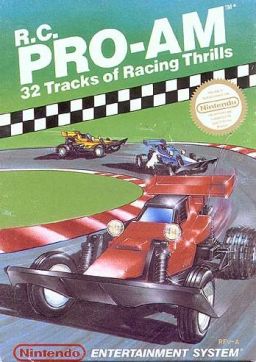
R.C. Pro-Am is a racing video game developed by Rare and published by Nintendo for the Nintendo Entertainment System. It was released in North America in February 1988, and then in Europe on April 15. Presented in an overhead isometric perspective, a single player races a radio-controlled car around a series of tracks in vehicular combat. Each track qualifies its top three racers for the next track. Collectible power-up items improve performance, hazards include rain puddles and oil slicks, and missiles and bombs can temporarily disable opponents. Originally titled Pro Am Racing, it was ported to the Sega Genesis in 1992 as Championship Pro-Am, an enhanced remake with enhanced graphics and additional features. R.C. Pro-Am spawned two sequels: Super R.C. Pro-Am in 1991, and R.C. Pro-Am II in 1992.

Castlevania II: Simon's Quest is a 1987 action role-playing game developed and published by Konami. It was originally released in Japan in 1987 for the Famicom Disk System, and in North America in 1988 for the Nintendo Entertainment System. It is the second Castlevania game released for the NES, following the original Castlevania (1986). Set seven years after the events of the first installment, the player once again assumes the role of vampire hunter Simon Belmont, who is on a journey to undo a curse placed on him by Dracula at the end of their previous encounter. Dracula's body was split into five parts, which Simon must find and bring to the ruins of Castle Dracula in order to defeat him. The game deviates from the traditional platforming of its predecessor, incorporating role-playing and open world elements.
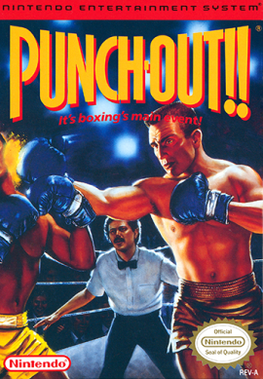
Punch-Out!!, originally titled Mike Tyson's Punch-Out!!, is a 1987 boxing video game developed and published by Nintendo for the Nintendo Entertainment System (NES). Part of the Punch-Out!! series, it is an adaptation of the arcade video games Punch-Out!! (1984) and Super Punch-Out!! (1984). Differences from the arcades include the addition of undisputed world heavyweight champion Mike Tyson as the final boss. It received critical acclaim, and is retrospectively considered one of the greatest video games of all time.
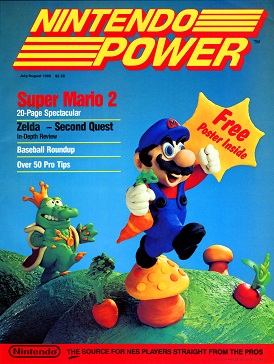
Nintendo Power is a video game news and strategy podcast and former magazine from Nintendo of America, first published in July/August 1988 as Nintendo's official print magazine for North America. The magazine's publication was initially done monthly by Nintendo of America, then independently, and in December 2007 contracted to Future US, the American subsidiary of British publisher Future. Its 24–year production run is one of the longest of all video game magazines in the United States and Canada.
Howard Phillips is an American video game consultant and producer best known as an early employee of and spokesman for Nintendo of America in the 1980s.

Snake Rattle 'n' Roll is a platform video game developed by Rare. It was published by Nintendo and released for the Nintendo Entertainment System in North America in July 1990 and in Europe on March 27, 1991. The game features two snakes, Rattle and Roll, as they make their way through eleven 3D isometric levels. A Mega Drive version was released by Sega in June 1993 with an extra level. Snake Rattle 'n' Roll was developed by Rare members Tim Stamper and Mark Betteridge. The music was composed by David Wise and was inspired by "Shake, Rattle and Roll" and other 1950s-era songs.

The history of the Nintendo Entertainment System (NES) spans the 1982 development of the Family Computer, to the 1985 launch of the NES, to Nintendo's rise to global dominance based upon this platform throughout the late 1980s. The Family Computer or Famicom was developed in 1982 and launched in 1983 in Japan. Following the North American video game crash of 1983, the Famicom was adapted into the NES which was launched in North America in 1985. Transitioning the company from its arcade game history into this combined global 8-bit home video game console platform, the Famicom and NES continued to aggressively compete with next-generation 16-bit consoles, including the Sega Genesis. The platform was succeeded by the Super Famicom in 1990 and the Super Nintendo Entertainment System in 1991, but its support and production continued until 1995. Interest in the NES has been renewed by collectors and emulators, including Nintendo's own Virtual Console platform.
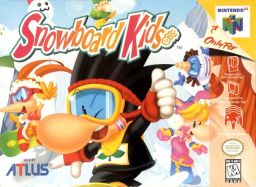
Snowboard Kids, is a snowboarding video game for the Nintendo 64. It was developed by Racdym and published by Atlus. Many reviewers compared its style to that of the Mario Kart series. An enhanced port, Snowboard Kids Plus, was released in Japan in January 1999 for the PlayStation.

M.C. Kids is a 1992 platform video game developed and published by Virgin Interactive. It was initially released for the Nintendo Entertainment System in February 1992 in North America, and by Ocean Software in May 1993 in Europe. As a licensed product for the McDonald's fast food restaurant chain, the game stars two children named Mack and Mick who venture into the fantasy world of McDonaldland in order to return Ronald McDonald's magical bag which has been stolen by the Hamburglar. The game was created by four people in eight months: Darren Bartlett Gregg Iz-Tavares and Dan Chang (programming) and Charles Deenen (audio).

Side Pocket is a pocket billiards simulation released as an arcade video game by Data East in 1986. It was ported to the Nintendo Entertainment System and Game Boy, while an enhanced remake was later released on the Sega Genesis, Super Nintendo Entertainment System, and Game Gear. The game spawned two sequels, as well as arcade spin-off series titled Pocket Gal.
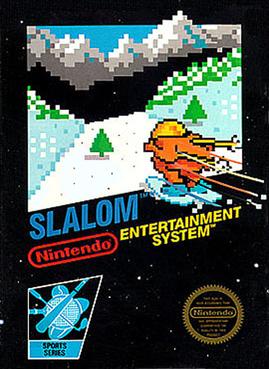
Slalom, originally released as VS. Slalom, is a skiing sports video game developed by Rare and published by Nintendo in 1986 for the Nintendo VS. System in arcades. It was then released for the Nintendo Entertainment System in North America in March 1987 and in Europe later that year. The player races in a series of downhill slalom skiing runs while navigating past flags and obstacles before time expires. It was developed by Tim and Chris Stamper and its music was composed by David Wise.
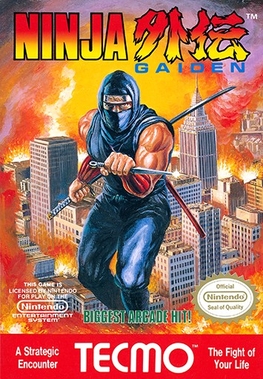
Ninja Gaiden, released in Japan as Ninja Ryūkenden and as Shadow Warriors in Europe, is an action-platform video game developed and published by Tecmo for the Nintendo Entertainment System. Its development and release coincided with the beat 'em up arcade version of the same name. It was released in December 1988 in Japan, in March 1989 in North America, and in August 1991 in Europe. It has been ported to several other platforms, including the PC Engine, the Super NES, and mobile phones.

Stadium Events is a sports fitness game developed by Human Entertainment and published by Bandai for the Nintendo Entertainment System. This and Athletic World are the two games in the Family Fun Fitness series, designed and branded for the short-lived Family Fun Fitness mat accessory for the NES. Stadium Events allows players to compete in four different Olympic inspired sporting events, using the mat to move as they compete in running and jumping focused gameplay.

Friday the 13th is a video game developed by Atlus and published by LJN for the Nintendo Entertainment System. Based on the horror franchise of the same name, players control counselors at Camp Crystal Lake as they attempt to defeat Jason Voorhees. The game received generally negative reviews, with criticism centered on its high difficulty and poor gameplay.
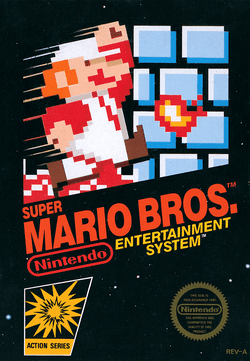
Super Mario Bros. is a platform game developed and published in 1985 by Nintendo for the Famicom in Japan and for the Nintendo Entertainment System (NES) in North America. It is the successor to the 1983 arcade game Mario Bros. and the first game in the Super Mario series. Following a US test market release for the NES, it was converted to international arcades on the Nintendo VS. System in early 1986. The NES version received a wide release in North America that year and in PAL regions in 1987.
Gail Tilden is an American marketing manager and consultant. She formerly worked at Nintendo of America where she was instrumental in helping with the advertising of the Nintendo Entertainment System's introduction to the North American market, and establishing the Nintendo Power magazine.

















